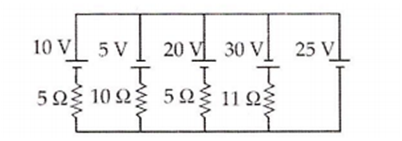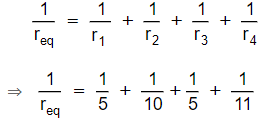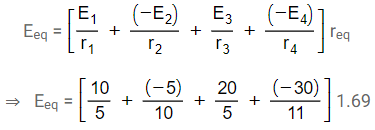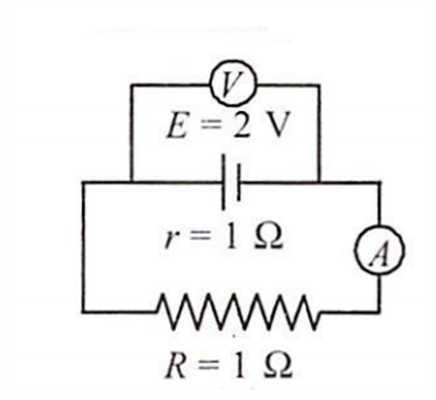 Multiple Choice Questions
Multiple Choice QuestionsA galvanometer has a current sensitivity of 1 mA per division. A variable shunt is connected across the galvanometer and the combination is put in series with a resistance of 500 Ω and cell of internal resistance 1 Ω It gives a deflection of 5 division for shunt of 5 ohm and 20 division for shunt of 25 ohm. The emf of cell is
47.1 V
57.1 V
67.1 V
77.1 V
In the circuit shown, current flowing through 25 V cell is

7.2 A
10 A
12 A
4.2 A
C.
12 A

E1 = 10 V r1 = 5 Ω
E2 = 5V r2 = 10 Ω
E3 = 20 V r3 = 5 Ω
E4 = 30 V r4 = 11 Ω
Equivalent resistance

⇒ req = 1.69 Ω
Equivalent voltage

⇒ Eeq = 4.68 V
Using Kirchoff's law for second loop
25 + 4.68 + i (1.69 ) = 0
⇒ i = 12 A
Assertion: It is advantageous to transmit electric power at high voltage.
Reason: High voltage implies high current.
If both assertion and reason are true and reason is the correct explanation of assertion
If both assertion and reason are true but reason is not the correct explanation of assertion
If assertion is true but reason is false
If both assertion and reason are false
The dimensions of specific resistance are
[ M L2 T-2 A-1 ]
[ M L3 T-3 A-2 ]
[ M L3 T-2 A-1 ]
[ M L2 T-2 A-2 ]
Assertion: The dimensional formula for product of resistance and conductance is same as for dielectric constant.
Reason: Both have dimension of time costant.
If both assertion and reason are true and reason is the correct explanation of assertion
If both assertion and reason are true but reason is not the correct explanation of assertion
If assertion is true but reason is false
If both assertion and reason are false
A bulb of 25 W. 200 V and another bulb of 100 W, 200 V are connected in series with a supply line of 220 V. Then
both bulbs will glow with same brightness
both bulbs will get fused
25 W bulb will glow more brightly
100 W bulb will glow more brightly
Assertion: A bird perches on a high power line and nothing happens to the bird.
Reason: The level of bird is very high from the ground.
If both assertion and reason are true and reason is the correct explanation of assertion
If both assertion and reason are true but reason is not the correct explanation of assertion
If assertion is true but reason is false
If both assertion and reason are false
Assertion: In the following circuit, emf is 2 V and internal resistance of the cell is I Ω and R= 1 Ω, then reading of the voltmeter is 1 V.

Reason: V = E IR where E = 2V, I = 2/2 = 1A
If both assertion and reason are true and reason is the correct explanation of assertion
If both assertion and reason are true but reason is not the correct explanation of assertion
If assertion is true but reason is false
If both assertion and reason are false.
Assertion: A domestic electrical appliance, working on a three pin will continue working even if the top pin is removed.
Reason: The third pin is used only as a safety device.
If both assertion and reason are true and reason is the correct explanation of assertion
If both assertion and reason are true but reason is not the correct explanation of assertion
If assertion is true but reason is false
If both assertion and reason are false.
Assertion: Ferro magnetic substances become paramagnetic above Curie temperature.
Reason: Domains are destroyed at high temperature.
If both assertion and reason are true and reason is the correct explanation of assertion
If both assertion and reason are true but reason is not the correct explanation of assertion
If assertion is true but reason is false
If both assertion and reason are false
